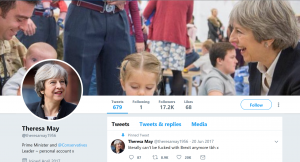
We are in the world of YASNS. The term was first coined by Clay Shirky in 2003, when he said we have on our hands ‘Yet another Social Networking Service’ [1]. Shirky was writing at a time when social networks were growing daily in number. Wikipedia currently lists around 200 active (or recently active) social networks. [2] On top of that there are companies which allow individuals or groups to create their own bespoke social network using proprietary software such as ning.com. Thus, although we are in a world dominated by the likes of Facebook, Instagram and Twitter there is a much larger ecosystem of smaller often bespoke social networks created for different languages, countries, cultures and special interest groups. If ‘Morethan Talk’ is to thrive it is going to have to take its place alongside a crowded market and draw users to itself.
The actual design of any social media platform needs careful consideration. There is evidence that at times the intentions of designers actually creates problems via unexpected consequences. For example, Twitter implemented a ‘tick’ in order to validate users as genuine bona fide celebrities. It meant that it was possible say to differentiate the genuine Theresa May’s Twitter feed (@theresa_may) from that of her interloper (@theresamay1956) whose feed is image for image identical yet the comments reveal a very different side to the Prime Minister. The tick was a simple visual design device to indicate to the world which influential Twitter users can be taken as genuine. Yet this endorsement of some users resulted in Twitter being criticised for appearing to demonstrate approval of say a white supremacists as the company sought to indicate who the real notorious racist was and by implication assert their trolls. [3]. The tick which the company wanted to represent the ‘genuine person’ was being understood as ‘those Twitter agree with’. Design needs careful consideration.

Others promote the development of ethical aspects to web designs. For example, it could be considered ethical for an app which is heavily used by young people to have a pop-up message which appears after the user has been online for a certain period of time to suggests it would be good to ‘take a screen break’ or ‘why not go and take some exercise?’ One goes even so far as suggesting that developers should be building systems that actually reward politeness, redemption and respect. [4]
Web designer Cameron Chapman identifies some characteristics of best design practise which include: having clarity about the purpose of the site. It should be evident within seconds of landing on the home page what the social network is seeking to achieve and how to join in. [5] Added to this, Chapman says it must be easy to find friends. This can be encouraged by having rich and varied criteria which can be applied to searches. The more criteria that a user can employ in a search, the more creative and hopefully fruitful their results can be. Arguably the fundamental feature of a social network should be that someone else’s friends are made visible to the user. [1] The effective social network will permit users to make social connections that without access to it they would not be able to make. This should certainly be a key feature of ‘Morethan Talk’.
There is a further ingredient for successfully encouraging people to participate in a social network. It concerns a user’s sense of belonging and thereby them believing that they have a social obligation to use the network. It has been identified as the ‘We-intention’. [6] The We-intention is a commitment by the individual to engage and join others in action. If the site is to be a success it will need to draw in those who are keen to learn or share language and culture with others. But it then needs to ensure that they actively participate. The sites with higher rates of We-intention are seen to be the ones with stronger group norms and subsequently closer cohesion. [6] So, it may be important to be very explicit about expectations. One key element of We-intention is that of ‘social presence’. In a computer setting the degree to which someone believes and is therefore cognisant that there is a genuine person at the other end of the communication. The degree of social presence is related to the degree of awareness of the other person in the communication. Computer mediated communication can be enhanced through the use of images of the user, using real names, and sharing other personal information. In this way there is a degree of reality built up about the other person. It seems therefore important that our site encourages users to build personal profiles, sharing as much information that they feel comfortable and, in this way, build the social presence that will be vital to the success of the site. [7]
Our design will need much thought so that it clearly indicates the purpose of the network to the user from the outset. If we can deliver clear expectations and help build social presence and consequently We-intention, then we should be successful if drawing an actively participating group of users who mutually benefit from using Morethan Talk.
References
[1] danah boyd and N. B. Ellison, “Social Network Sites: Definition, History, and Scholarship,” Journal of Computer-Mediated Communication, vol. 13, pp. 210–230, 2008.
[2] Wikipedia https://en.wikipedia.org/wiki/List_of_social_networking_websites, Accessed 21 March 2018
[3] F. Miller, “Ethical design is the answer to some of social media’s problems,” The Conversation, 17-Jan-2018. [Online]. Available: http://theconversation.com/ethical-design-is-the-answer-to-some-of-social-medias-problems-89531. [Accessed: 21-Mar-2018].
[4] D. Karr, “https://martech.zone/time-for-a-new-social-network/,” Mar Tech, 17-Jan-2018. [Online]. Available: https ://martech.zone/time-for-a-new-social-network/. [Accessed: 19-Mar-2018].
[5] C. Chapman, “Social Network Design: Examples and Best Practices,” smashngmagazine.com, 13-Jul-2009. [Online]. Available: https://www.smashingmagazine.com/2009/07/social-network-design-examples-and-best-practices/.
[6] C. M. K. Cheunga, P.-Y. Chiua, and M. K. O. Leeb, “Online social networks: Why do students use facebook?,” Science Direct, vol. 27, no. 4, pp. 1337–1343, Jul. 2011.
[7] Kehrwald, B. (2008). Understanding Social Presence in Text-Based Online Learning Environments. Distance Education, 29(1), 89-106.
No comments yet.